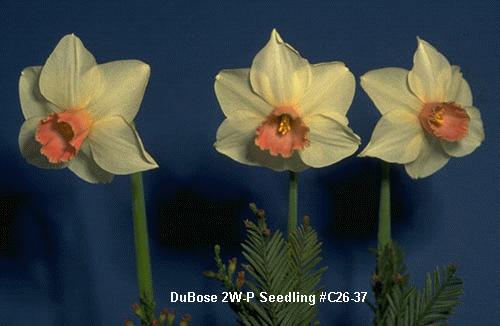(1) Visit the Northern California Daffodil Society’s daffodil shows in March and see the many different varieties available. Also during March, visit the display gardens at Ironstone Vineyard in Murphys. Nothing beats seeing the different blooms. Decide what colors and forms you like best.
(2) Write, telephone, or e-mail growers for their catalogs in late March or April. Order and pay for your bulbs in April or May. Growers will ship the bulbs to you in September. Put them in a cool and airy place until planting time – when night-time temperatures have cooled and the soil temperature has dropped.
(3) If you live in a warm-summer, mild-winter climate, refrigerate your new bulbs for several weeks after receiving them to supply some of the winter chill they previously received but won’t get in your winter. This will help them adapt to their new climate. Plant bulbs in mid- to late November.
(4) Choose a well-drained, sunny place. Hillsides and raised beds are best. DRAINAGE is the key. Spade at least twelve inches deep. Improve your clay with well-rotted compost, soil amendment, or planting mix and raise the bed. Slightly acidic soil is best, so you might add soil sulfur if you have alkaline soil.
(5) Plant your standard -sized daffodil bulb approximately 6″ deep. Plant miniature bulbs about 2″ deep. Exactness isn’t crucial; they’ll adjust. Plant bulbs deeper in sandy soil than in clay. The top of the bulb is the pointed end.
(6) If you are to leave them down for years, then work some low-nitrogen fertilizer into the soil. After planting, top-dress with a sprinkling of 5-10-10. Top-dress again with 5-10-10 when the leaf-tips emerge. As they flower, top-dress with 0-10-10 or 0-0-50. High-nitrogen fertilizer should be avoided.
(7) If you plant your bulbs before the rainy season starts, don’t water the bulbs upon planting. Wait until the rains come, or at least until when the rain should come. Bulbs send out roots when they detect moisture and they are susceptible to fungal infection at this time. Basal-rot fungus is endemic in the soil but goes dormant at cool soil temperature – that is the reason to wait.
(8) Daffodils need lots of water while they are growing. Continue watering for three weeks or so after blooming time; then stop watering. The bulbs make their next year’s bloom after flowering. (Your first-year bloom is largely due to the previous grower of the bulb.)
(9) You may leave daffodils down if your area is DRY during the Summer. If you water, or want to grow other things there, then you must dig them. WARMTH + MOISTURE = BULB ROT. Plant tazettas for naturalizing – most will tolerate Summer water.
(10) Never cut the foliage until it begins to yellow (usually late May or June). Then is the time to dig the bulbs. Wash the bulbs thoroughly and let them dry completely (at least a week, out of the sun). Put them in onion sacks (or panty hose) and hang them until November in the coolest place you can find. Good air circulation keeps storage rot at a minimum.
(11) Join the NCDS and get quality bulbs cheaply at our October raffle party. And, have a good time socializing with another group of garden folks. The following spring, bring your prize blooms to one of our events and show your growing skills.
